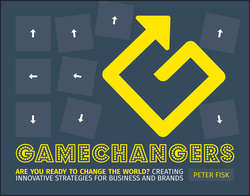Читать книгу Gamechangers - Fisk Peter - Страница 9
На сайте Литреса книга снята с продажи.
PART 1
ARE YOU READY?
1
PLAY.. THE GAME
THE GAME, CHANGE THE GAME
THE END OF THE WORLD AS WE KNOW IT
ОглавлениеWhen Henry Ford launched his Model T in 1908 his Detroit assembly line, his innovative product and his pioneering marketing machine transformed an industry. His efficient mass-production methods reduced prices, improved quality and created vast wealth. He dominated the market, and by 1918 half the cars in America were Fords.
It was the third wave of the industrial revolution.
The first wave of the industrial revolution had been about invention – from the forging of iron in the Shropshire valleys, the spinning jenny for making textiles, and James Watt's steam engine. The second wave was about application – Robert Fulton's steamboat on the Hudson River, Alexander Bell's telephone, and Thomas Edison's light bulb.
The third wave was about transformation, when the innovations take on a scale and can change the world – from the mass production of cars, railways and airplanes, to huge factories and modern medicines. This transformed people's lives, improving health and education, the growth of cities and international trade.
Whilst the industrial revolution had begun in the north of England, making Britain powerful and wealthy, it soon spread across Europe and to America, and in later years beyond, particularly to Japan. It was 250 years of disruption, after 7000 years of a society based around agriculture.
Waves of Digital Revolution
Now, as that age closes, we are in the midst of the digital revolution – embarking on the third wave of a new age that will change the world again, even faster.
The first wave, about invention, started with transistors that led to integrated circuits, the rise of computers and the miniaturization of machines.. from video games and mobile phones through to 1990 when Tim Berners Lee introduced the World Wide Web.
The second wave, about application, is well known to us today. Internet and mobile communications pervade our lives: shopping on Amazon with our Apple iPads, a world of knowledge through Google and Wikipedia, a world without borders through Facebook and Skype. First distracting us, now embraced as the way we live.
The third wave of the digital revolution is when everything changes, when digital is transformational, when power really shifts.
Whilst the last 20 years of technology has inspired us, it is only now that the game really changes – when the ‘gamechangers' shape the future. Mass production is rapidly becoming obsolete, 3D printers are already replacing factories, companies work in virtual networks, products are bought on demand and customized by default, whilst personal channels are replacing stores which used to second guess what people wanted.
In the past we created average products for average people. We made the products ourselves in big factories that absorbed significant capital investment. We needed to sell on a huge scale to secure a return on investments. Markets were largely homogeneous because every competitor was close to average, therefore we could measure results by market share. We used mass-market, broadcast advertising with average messages, at times to suit us, pushing people to buy more of what we wanted.
This game doesn't work anymore. That was the industrial age. Soon we will see the end of factories, shops and advertising.
Digital is by its nature not about size or geography, capability or experience. It is borderless and democratized, enabling anyone to have an impact. Mikael Hed sits in Espoo creating games like Angry Birds that entertain the world; Eric Magicovsky could be anywhere raising $10 million from 69,000 people on Kickstarter to launch his Pebble smartwatch; Vicky Wu flies between LA and HK building ‘prosumer' demand for her latent fashions with ZaoZao.
This is the third wave of the digital revolution, where ideas can change people's lives, where anybody can change the game.
